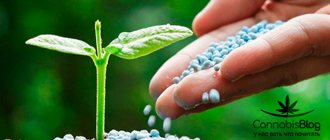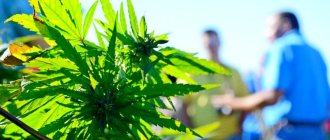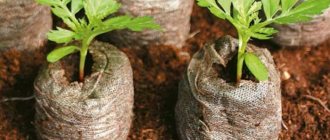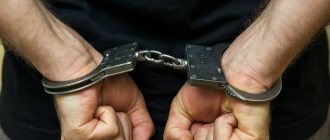Arbitrage practice
Situation 1. In Astrakhan, a 45-year-old man was convicted of growing hemp, which he cultivated in one of the farms.
Hemp plantations were hidden behind strawberry and raspberry bushes. The attacker watered the “grass” using drip irrigation, so the grown hemp reached a size of 2 meters. In total, investigators counted about 700 bushes of illegal weed growing on an area of about 250 square meters. m. During the proceedings, it was established that the suspect had previously been prosecuted for the illegal acquisition and storage of illegal substances. The judge sentenced him to 3 years in prison in a general regime colony on the basis of Article 231 of the Criminal Code of the Russian Federation. Situation 2. Police in Omsk detained a 35-year-old local resident who set up a drug laboratory in his own garage. The man grew hemp. He equipped the garage with special lighting and installed an air conditioning and irrigation system. Each hemp bush (and there were 34 bushes) was carefully tied up, and the owner fertilized the “grass.” Police also found dried cannabis weighing about 200 grams in the garage, which the owner had prepared for sale. For the illegal cultivation of plants containing narcotic substances, a local resident was sentenced to imprisonment for a period of 1 year and 5 months in a general regime colony.
Situation 3. A resident of Vladivostok appeared in court for illegally cultivating plants containing narcotic substances on an especially large scale. As part of Operation Poppy, the police found a plot in one of the plantings where an illegal citizen was growing 1,200 hemp bushes, which he carefully tied up, fertilized and watered. The man admitted his actions and repented of his actions. A case was initiated against him under Art. 231 of the Criminal Code of the Russian Federation. The court found the suspect guilty and sentenced him to imprisonment for a period of 4 years and 6 months in a special regime colony.
In our country, growing hemp is a criminal offense, since this plant is a narcotic “weed” from which marijuana, hashish, etc. can be prepared.
For growing this drug-containing plant on a large and especially large scale, criminal liability is provided under Art. 231 of the Criminal Code of the Russian Federation.
The sanction of the article provides for several punishment options, ranging from a fine to imprisonment for up to 8 years.
How many cannabis bushes can you grow? Legal basis
Cannabis is viewed negatively in Russia - for decades, anti-drug propaganda has formed the impression among our fellow citizens that the plant is of interest exclusively to drug addicts, and simply cannot be used in any other way. However, perhaps this will cause considerable surprise for some readers, but the legislation of the Russian Federation is not so clear about the cultivation of this weed, and in this article we will look at how many hemp bushes can be grown in Russia by law, and what is needed for this.
Potential benefits from industry development
Government authorities still do not favor marijuana, not wanting to adopt the positive experience of Europeans who use cannabis to produce effective medicines, biofuel, textiles, and a whole range of other useful and sometimes irreplaceable things. But there are simply no analogues to some medical preparations based on green raw materials; for example, epilepsy is treated with these drugs and severe pain is relieved. Hemp fabrics and paper are much stronger than products made from cotton and wood; moreover, biofuel from the resulting oil may well revolutionize the entire energy industry - its extraction from easily renewable raw materials may turn out to be cheaper than mining.
Is everything really forbidden? Let's talk about seeds...
Today, this weed in Russia has the status of a raw material for narcotic drugs; accordingly, the circulation of such drugs is under the control of the government. Cannabis-based medications are not used in domestic medicine, and citizens cannot legally use, store and sell; there are also restrictions and issues of growing for one’s own needs, as well as cultivation - all this cannot be done.
On the other hand, the seeds were not banned; on the basis of the international anti-drug convention, to which the Russian Federation joined, the seeds were brought into the legal realm, since they do not contain tetracannabinol, which causes certain psycho-emotional effects. The seeds are freely available, as are derivatives based on them, for example, oil can be bought at a pharmacy - this is a good dietary supplement that helps with various diseases, and the grains are sold in pet stores and are used as bird feed. Making tinctures and cosmetic masks at home is also not a violation. Export is also not prohibited, and many varieties come to us from countries where they are legally cultivated.
What will happen if...?
But if you suddenly want to use these grains as seed, then you need to know that such actions are discussed in Art. 231 of the Criminal Code of the Russian Federation. Accordingly, preventive measures are provided for this - from a fine (1500 rubles - 4000 rubles) to imprisonment, depending on the volume and other circumstances.
For example, if a few bushes are found on the site (up to twenty), the punishment will be imposed within the framework of administrative liability, and if a small plantation is discovered (twenty or more), then criminal liability will be imposed, namely, isolation from society for up to two years.
It is possible, but subject to conditions. Licensing and inspections
However, on the other hand, even in modern legislation there are indications of varieties that are permissible to grow, that is, under appropriate circumstances this can be done. There are several dozen technical subtypes, where the THC content is reduced to almost zero; they cannot be used to obtain various products that can cause any effects in terms of emotional or mental impact.
These subspecies were traditionally used for the needs of the textile industry back in Soviet times, and hemp was the most profitable crop, which gave more profit (per hectare) than other crops (cereals, legumes, etc.). At present, no one is stopping anyone from doing this; already in Soviet times, a legislative framework, rules for issuing appropriate permits, and a methodology for conducting analyzes for the threshold content of cannabinoids were developed. The latter is the main requirement for domestic hemp growers; by the way, such licensing practice is used not only here, but throughout the world.
Naturally, in addition to documents, it is really necessary to create special conditions - to provide security, fence the perimeter, and maintain strict reporting on harvests and supplies. Domestic businessmen who work in this direction often encounter bias from regulatory authorities, who in some cases try to substitute tests, thereby causing a lot of trouble. By the way, as a result of the actions of his own employees (who may sow part of the area with the “wrong” variety), the farm owner may seriously suffer.
And a little about selection
Cultivation - the breeding of varieties that meet certain characteristics, is also allowed, of course, only within specialized research institutes; several large agricultural institutes in different cities were inherited from the Soviet era. But if you suddenly decide to justify the presence of several “weeds” in your yard for purely research purposes, then you must have documents stating that you have the right to conduct such activities. Otherwise, the thirst for knowledge will quickly be reclassified as an act described in the Criminal Code.
World practice. How is this going abroad?
There are several countries in the world where this area of agriculture is actively developing, which is very promising. In addition to pharmaceuticals and fabrics, paper is made from cannabis (in particular, for US dollars), as it is more resistant to wear and tear, biofuel, environmentally friendly, “natural plastics” - it is estimated that plant starting components can be used to make tens of thousands of products.
The leading country in this regard is China - it has fairly strict legislation, which has made it possible to minimize consumption among the population. At the same time, in two regions at once there are industrial crops and dozens of private farms that are licensed and earn good money (this is more profitable than planting rice). By the way, the Celestial Empire has actually managed to capture the market for “medicinal marijuana,” which is exported and is also used to manufacture numerous medications within the state (for domestic needs and for export).
They do this in the Netherlands too, however, the focus here is completely different, the product is mainly for sale within Europe and is intended, let’s say, for relaxation. It is allowed to consume marijuana here, but there are quite a lot of restrictions - you can’t sell it to minors, you can’t smoke in public places, there are specially designed “coffee shops” for this, where you can buy everything you need.
By the way, in many European countries, citizens are given the opportunity to have a few plants in their yard or on their windowsill without persecution or any consequences.
In the United States, perhaps, there is the most ambiguous attitude towards the subject. In some states, you can do everything - use, plant and carry with you; in a number of territorial entities only technical or medical varieties are welcome, and in some places everything related to hemp is prohibited.
In states where marijuana has been legalized, a whole industry has already formed within a decade, and legal millionaires have appeared. However, some issues could not be resolved, for example, many entrepreneurs who work in this niche have difficulties with banks. Many banking networks operating throughout all districts refuse to process payments and service accounts, because the financial system is strictly bound by global legislation that is aimed at combating drug trafficking and money laundering. Such businessmen do not always manage to purchase the necessary equipment (cash payments in large transactions are simply not accepted) or otherwise obtain investment funds.
The amazing is nearby: the Uruguayan example
In an interesting way, everything is structured in Uruguay, where cannabis is sold directly in pharmacies, and local residents can sow it legally and use it as they please, they just need to submit a special application to the registration authority. How much marijuana can local residents grow? No more than six bushes per house; they must be registered with government agencies.
But joint cultivation of hemp is also allowed; for this purpose, it is permissible to unite in groups and conduct collective farming. The authorities were prompted to make this decision by the idea that legalization would lead to the absence of a criminal component in circulation. The cost of a serving is just over a dollar, which is much cheaper than before, dealers have left the streets, and criminals have lost a significant part of their profits, which went to finance other illegal projects.
Conclusion
So, what's the bottom line? In fact, for now all manipulations with grass can only be carried out in specialized enterprises; private individuals cannot even get close to this area; doctors are also deprived of advantages. The chances of a quick lifting of restrictive acts tend to zero, which is confirmed by government policy. As the President recently stated, he is not against technical exploitation, but the use of the plant as a drug for general consumption (for therapeutic purposes or for relaxation) is unacceptable.
Discuss on the forum
This article was prepared with the support of the GrowerZ store
Responsibility for growing hemp according to the law in the Russian Federation
Art. 12.
Law on Limited Liability Companies (LLC Law 2021) There are many countries where marijuana is legalized, including permitted as an agricultural crop. But the Russian Federation is not one of such states. In Russia, unauthorized landings are still strictly prohibited
It doesn’t matter whether it’s growing hemp on a windowsill at home, a couple of bushes in a greenhouse or a hectare on a farm. The size of the plantation will only affect the severity of the punishment
Regulations
The prohibition of hemp falls under Article 10.5.1. “Illegal cultivation of plants containing narcotic drugs or psychotropic substances or their precursors” of the Code of Administrative Offenses. The term “cultivation” in it means both cultivation itself and selection, breeding new varieties, experiments with the selection of fertilizers, watering, lighting to obtain a better harvest. As we have already mentioned, only federal state unitary enterprises with a special license can do this in Russia.
Amendments to the legislation appeared thanks to the Federal Law of May 19, 2010 No. 87 “On amendments to certain legislative acts of the Russian Federation on the issue of cultivation of plants containing narcotic drugs or psychotropic substances or their precursors.” But they only concern the abolition of criminal prosecution for a minimum amount of cannabis. Unauthorized (including home) cultivation of cannabis remains prohibited.
Penalty for growing cannabis at home
Liability for marijuana depends on the quantity. For storage, sales, and transportation, the following gradation has been introduced:
- a small amount (up to 6 grams);
- significant (from 6 to 100 grams);
- large batch (more than 100 grams);
- especially large batch (from one hundred kilograms).
When growing, the calculation is different.
It doesn’t matter whether a person has planted one bush or more – cultivation is still considered illegal. But if a personal plantation contains less than 20 bushes, then the punishment will be exclusively administrative: a fine of 1,500 to 4,000 rubles or 15 days of arrest
That is, the answer to the question: “Is it possible to grow hemp at home?” in any case - “No!” But there will be no criminal case for a few bushes.
If the police find more than two dozen bushes (that is, we are clearly not talking about personal “pleasure”), then the punishment will be imposed according to the Criminal Code, and, naturally, it will be much more severe:
- imprisonment or restriction of liberty for up to 2 years;
- community service (up to 480 hours);
- a large fine (from 40 to 300 thousand or up to two annual salaries).
In aggravating circumstances (sales via the Internet, distribution in educational institutions, organized group, repeated recruitment, etc.), the term may increase to 8 years.
The foreigner will also be deported.
By the way, you don’t need to think that when growing at home, “no one will see, no one will know.” Cultivated cannabis (the one from which the drug can be obtained), unlike industrial varieties, is a very capricious plant. The frenzied increase in the meter for powerful lighting, the purchase of special fertilizers and other signs give hemp growers away. And even the most ignorant neighbors will recognize the characteristic foliage.
Is it possible to grow hemp for personal use?
Federal Law No. 3 clearly establishes a ban on the cultivation of narcotic plants for any purpose. Since cannabinol is contained even in hemp seeds, it cannot be grown.
There is also a list of prohibited plants No. 934, in which this plant also appears.
The qualification of violation of these prohibitions depends on the number of plants:
- Less than 20 bushes are considered insignificant in size. Responsibility will arise under Article 10.5.1 of the Code of Administrative Offenses of the Russian Federation. This article provides for a fine of 1.5-4 thousand rubles or arrest for 15 days.
- When growing more than 20 bushes, liability will arise under Article 231 of the Criminal Code of the Russian Federation. They can be punished with a fine (up to 300 thousand rubles), compulsory labor (up to 480 hours), restriction or imprisonment (up to 2 years). However, if the crime is committed by several people, the prison term will increase to 8 years with a possible additional restriction of freedom for 2 years.
- Particularly large size (more than 330 bushes) is punishable under the same article 231, but only by imprisonment for 8 years. Even a small sprout of hemp is considered a bush.
Answering the question whether it is possible to grow hemp, it becomes clear that liability is provided for by law in any case and often a “lover” of weed can be imprisoned for a long time.
Growing industrial hemp: what you need to know about the technology
New disability law in 2022
Industrial hemp, in particular represented by specially bred varieties with a set of desired properties (tall growth and a powerful stem are preferable for using hemp for fiber, and bushiness and abundance of fruiting tops are preferable for obtaining a rich harvest of seeds) in general, the crop is unpretentious. It can grow almost anywhere, but the optimal soils are fertile chernozem soils, lowland peat bogs and loams. Groundwater should lie no higher than 0.75 m below the soil surface. It is also worth considering the nutritional needs and preferences of the plant. Hemp “loves” nitrogen, “sucking” it out of the soil, and consumes potassium to a lesser extent, so the soil should be additionally enriched with nitrogen fertilizers. Tillage before sowing is carried out three times: in autumn, early spring and immediately before sowing.
Before you sow a field and start growing industrial hemp, you need to decide what you need in the end:
- If hemp is grown for the purpose of obtaining seeds, then it is worth choosing varieties such as Victoria and Glyana, which are capable of producing 1-1.2 tons of seeds per hectare at a consumption rate of only 15 kg of seeds for sowing 1 hectare (sparse sowing). Taking into account all expenses for the purchase of seed, cultivation, harvesting, preparation, the profit will be 112.5%.
- If the priority is green mass, 70-80% represented by stems, then “dense” sowing is used with a rate of about 100 kg of seeds per hectare. Suitable varieties Glyana and especially Nika (with stem height up to 3 m and straw yield up to 11.5 t/ha).
The technology for growing industrial hemp has many other nuances, but they are quite easily taken into account and do not negatively affect profitability.
Lighting
Your lamp will be the most expensive part of the process, but there are relatively inexpensive lamps available for this purpose. Serious growers use more specialized and expensive lamps. But for growing just one plant at home, there are many easy options. You can find a 250-watt HID or HPS bulb in hardware stores. These lamps require special mounting or ballast as they do not securely screw into any standard household socket. If your windowsill has a lot of light and sun, you can alternatively use fluorescent lights to supplement the sunlight after sunset. Fluorescent lamps such as T5, T8 or even CFL can provide enough light to support your plant through the growing season. However, remember, the less intense the light, the slower the plant will develop. For plants that receive strong sunlight during the day, fluorescent bulbs should only be used as a supplemental light source. If the light provided during the day is too low, the plant will be thin and weak and not develop enough to harvest. If so, consider using a 250-watt HID option for a full 12-hour photoperiod during flowering, away from a window, in a separate, enclosed area.
Arbitrage practice
When and how you can declare yourself bankrupt: law, procedure, consequences
Situation 1. In Astrakhan, a 45-year-old man was convicted of growing hemp, which he cultivated in one of the farms. Hemp plantations were hidden behind strawberry and raspberry bushes. The attacker watered the “grass” using drip irrigation, so the grown hemp reached a size of 2 meters. In total, investigators counted about 700 bushes of illegal weed growing on an area of about 250 square meters. m. During the proceedings, it was established that the suspect had previously been prosecuted for the illegal acquisition and storage of illegal substances. The judge sentenced him to 3 years in prison in a general regime colony on the basis of Article 231 of the Criminal Code of the Russian Federation.
Situation 2. Police in Omsk detained a 35-year-old local resident who set up a drug laboratory in his own garage. The man grew hemp. He equipped the garage with special lighting and installed an air conditioning and irrigation system. Each hemp bush (and there were 34 bushes) was carefully tied up, and the owner fertilized the “grass.” Police also found dried cannabis weighing about 200 grams in the garage, which the owner had prepared for sale. For the illegal cultivation of plants containing narcotic substances, a local resident was sentenced to imprisonment for a period of 1 year and 5 months in a general regime colony.
Situation 3. A resident of Vladivostok appeared in court for illegally cultivating plants containing narcotic substances on an especially large scale. As part of Operation Poppy, the police found a plot in one of the plantings where an illegal citizen was growing 1,200 hemp bushes, which he carefully tied up, fertilized and watered. The man admitted his actions and repented of his actions. A case was initiated against him under Art. 231 of the Criminal Code of the Russian Federation. The court found the suspect guilty and sentenced him to imprisonment for a period of 4 years and 6 months in a special regime colony.
Question: I grow a couple of marijuana bushes at home (for myself). A friend said that you can plant up to 6 bushes of grass at home. Is this so, will I not be held accountable?
Answer: In fact, you cannot grow narcotic plants at home or in your garden (dacha, etc.). Another thing is that for growing cannabis in an amount of up to 20 bushes you can be held administratively liable. Over 20 bushes are already facing criminal liability.
Question: What will it cost me to grow hemp if I plant it on my property?
Answer: It doesn’t matter where you planted this plant: in your house, in your garden, on rented land. The main thing is that you are engaged in illegal activities
So, you may be subject to either administrative (if the size of the “grass” grown is small) or criminal liability.
Question: At what age can a person be held accountable for sowing and growing hemp?
Answer: Persons over the age of 16 are subject to criminal liability for such a crime.
In our country, growing hemp is a criminal offense, since this plant is a narcotic “weed” from which marijuana, hashish, etc. can be prepared.
For growing this drug-containing plant on a large and especially large scale, criminal liability is provided under Art. 231 of the Criminal Code of the Russian Federation.
The sanction of the article provides for several punishment options, ranging from a fine to imprisonment for up to 8 years.
How is hemp used in China?
Industrial hemp is becoming popular not only in Russia, but also abroad. For example, in China they make clothing for soldiers from it. Initially, this approach was already used in the mid-1970s, when the Chinese army was poor. At that time, clothes made from industrial hemp were cheaper than those made from linen or synthetics. But the practice resumed in 2010, although no longer due to economic, but due to practical considerations.
Hemp fibers allow air to pass through better and facilitate thermoregulation compared to cotton, which is important for regions with hot climates (southern provinces). Therefore, now in China socks, T-shirts and underwear for soldiers are made from industrial crops.
Since 2022, China has been implementing a program to cultivate and grow a technical frost-resistant variety. This takes place in Heilongjiang Province, which borders Russia. Thanks to the breeding of industrial species capable of growing in regions with low air temperatures, breeding is possible over a vast area of the country. Now industrial hemp grown in China accounts for half of all areas in the world sown with such a crop. Of the 600 patents on plant cultivation, half were also issued to Chinese farmers.
The program is strictly controlled by the state, but is steadily gaining momentum as textile factories begin to buy up the stems, pharmaceutical plants take the leaves, and the seeds go into the kitchen. In China, industrial hemp from 1 hectare of land brings up to $1,500, while growing corn or other agricultural plants brings $200-300 from the same area. Technology moves on, and hemp is slowly becoming “green gold.”
Growing hemp in China
Is it possible to buy hemp seeds?
The law does not provide for liability for the sale and purchase of hemp seeds. This is explained by the fact that they do not contain the psychoactive substance tetrahydrocannabinol, contained in the leaves and inflorescences. Most of it is concentrated in a sticky resin secreted from the flowers of the female plant.
Composition of hemp seeds
The seeds themselves consist of 49% oil, saturated with Omega-3 and Omega-6 fatty acids. They also contain:
- 65% globulin and albumin (more than any other plant known to science);
- 18 amino acids, including essential ones;
- B vitamins;
- potassium, calcium, iron and other trace elements.
Legal uses of hemp seeds
Additionally, in European countries, hemp seeds are sold in beautifully packaged boxes labeled “Souvenir”. Russian entrepreneurs are interested in whether it is possible to sell such souvenir products in Russia. However, do not delude yourself. Usually, even if there is an indication that these seeds are a souvenir, the instructions write the characteristics of the variety and the yield of the plant, which implies the possibility of growing it. Therefore, seed trading is precisely the case when the risk is unjustified.
Hemp seeds can be used to make:
- hemp oil;
- cosmetic masks;
- medicinal mixtures;
- culinary dishes;
- birdseed;
- other legal purposes.
Legal precedents
The mere presence of seeds does not mean the cultivation of marijuana and is not a reason to detain their owner. However, it may serve as a basis for carrying out (Federal Law No. 3 “On Narcotic Drugs...” dated January 8, 1998):
- Personal search.
- Checks of postal parcels, luggage, cargo, car.
- The so-called “premises inspection”, which is comparable to a search. Done in the event of a court decision.
By “reason” is meant the assumption of possible storage, shipment or transportation of narcotic and psychotropic substances. Also, when storing hemp seeds, a criminal case may be initiated for the preparation of narcotic drugs if:
- Objects intended for cultivating the plant were discovered. For example, phytolamps for growth, special soil, containers for sowing seeds.
- The intention to grow hemp was repeatedly expressed in the presence of witnesses, which is confirmed by their testimony.
Watch in the next video how an ordinary apartment was turned into a hemp plantation, and what the punishment was for this.
Criminal liability for marijuana
For a number of actions with marijuana, Articles 228 and 228.1 of the Criminal Code of the Russian Federation provide for punishment. The following actions are criminally punishable:
- Manufacturing and processing of drugs.
- Storage.
- Transportation.
- Distribution, including free.
It is important to understand that while there is no criminal penalty for the use of marijuana, there is one for its possession. In practice, it is difficult to imagine use without storage
What weight of marijuana is punishable by criminal charges?
According to Government Decree No. 1002, the following quantities of stored drugs are established, on the basis of which a specific punishment is assigned:
- Significant size - 6 grams.
- Large – 100 grams.
- Extra large – 100,000 grams.
The punishment can be significantly increased in case of large and especially large quantities of drugs seized.
Punishment for possession of marijuana
As mentioned above, the punishment depends on the size of the drug stored:
- If the amount is significant, the maximum penalty is imprisonment for up to 3 years. But more often they impose correctional, compulsory labor, a fine or restriction of freedom.
- If the amount is large, imprisonment will be mandatory - up to 10 years. Additionally, a fine of up to 500 thousand rubles will be applied and freedom will be limited for a year.
- A particularly large size will result in a sentence of 10 to 15 years. If there are mitigating circumstances, the court may limit itself to the minimum figure.
The law defines only one way to avoid liability - to hand over marijuana to the police voluntarily.
Punishment for distribution of marijuana
Selling any drugs is the most serious crime. The fact that marijuana is a so-called soft drug does not reduce the degree of punishment:
- According to the first part of Article 228.1 of the Criminal Code, sales will be punished with 4-8 years in prison.
- The significant amount of the drug increases the possible sentence to 8-15 years.
- Large size - up to 10-20 years.
- Particularly large - up to 15-20 years.
If a criminal sold drugs in public places or through the media, then even with a minimal quantity, the prison term is determined within 5-12 years.
Can they be planted for buying or selling hemp seeds?
Since hemp seeds also contain a narcotic substance, albeit in small quantities, there is also liability for trading in them.
Government Decree No. 460 of 2007 approved a list of permitted hemp varieties that contain a minimum cannabinol content. Such varieties can be sold, but only for industrial purposes, and if there are documents confirming that the seeds belong to this particular variety.
The following gradation has been established for the THC (tetrahydrocannabinol) content in hemp seeds:
- Significant size - more than 0.05 grams.
- Large size - more than 0.25 grams.
- Particularly large - more than 50 grams.
According to the size, the punishment for selling seeds differs.
Find a place outside
The first thing to do when planting cannabis is to find the space that best suits the growing requirements. Your plants should receive as much direct light as possible to produce bushy textures and heavy buds. It is best to find a place with a southern orientation if you are in the northern hemisphere, and vice versa if you are in the southern hemisphere.
If you want to grow on your own property, find a place with good drainage and healthy soil. Additional considerations include protection from strong winds, privacy and quick access.
Where to begin
First, let's eliminate any fear that this will be difficult. Will not be. An important aspect of home growing that everyone should understand is that hemp is a flowering plant, which means that in nature it bears fruit only once a year in the fall, when there is less daylight. This is important for home indoor plant growing because the light regime (photoperiod) of the plant must be controlled. To put it simply, this means that the plant in the pot must receive more than 12 hours of light every day in order not to bloom. You may ask, “Why not just let the plant flower immediately, collect the beautiful buds, and start smoking?” Truth be told, you could do it. But if an unripe bush blooms too early, there will be little harvest. To achieve a healthy, well-developed crop, young seedlings should be grown for 4-6 weeks before inducing flowering. During this time, the bush should receive at least 16 hours of light, 18-20 hours is also quite good. To do this indoors, even near a window with good sunlight, you will need a lamp to ensure the proper photoperiod length.
Commentary to Art. 231 of the Criminal Code of the Russian Federation
Article 231 of the Criminal Code of the Russian Federation, which provides for punishment for the cultivation of drug-containing plants, is necessary to prevent the cultivation of such crops for the purpose of consumption or distribution. The commentary to this article explains why people are sentenced under this article.
The offender will be considered guilty if he carries out certain actions or procedures for the cultivation of crops such as hashish, cannabis or other plants that have a narcotic effect.
Such actions are:
- sowing seeds of these crops;
- growing plants;
- creating conditions for favorable plant growth;
- obtaining a harvest of these plants.
However, some varieties of opium crop, such as poppy, can settle in areas as wild grass.
In such situations, the owner of the plot needs to carry out weeding work to stop the growth of grass next year. If he does not take such actions, but also does not contribute to the growth of grass, then his actions can be reviewed under an administrative article, in which case he will receive punishment in the form of a fine or correctional labor. As consultants note, quite often citizens independently destroy grass that grows spontaneously.
The creation of favorable conditions for the cultivation of these plants is understood as a set of works by which a person helps the plant actively grow and mature:
- Selection of the best seeds.
- Sowing.
- Development of land for sowing.
- Finding a suitable piece of land where the grass will grow.
- Removing weeds and watering plants.
Thus, the culprit will intentionally commit a crime; by his actions he will promote the growth and flowering of plants that are prohibited from cultivating for personal purposes.
If the crime was detected at the stage when the plants are suitable for consumption, then their quantity is estimated by bush or in grams. In this case, the part of the article applicable for growing marijuana may be changed, and the citizen will receive a criminal sentence.
The amount of products that were cultivated illegally, and which affects the degree of punishment, is measured in practice using special lists containing recommendations on what is considered large or especially large sizes. These lists may be subject to revision if legislation decides to amend them. Basically, the parameter that is subject to change is one that determines how many bushes or grams of product will be classified as small or large. Depending on this, the federal court will impose a punishment.
We provoke flowering
Once your plant has developed enough and can produce enough flowers for a decent harvest, it is time to work up the light cycle to 12 hours of light and 12 hours of darkness each day. This doesn't mean you won't need your lamp anymore. During the 12-hour flowering photoperiod, cannabis needs strong light, which can help it produce energy for its buds. If your plant can be exposed to direct sunlight during those 12 hours, you won't need much supplemental lighting. However, even outdoors this is usually not possible. Your best option for flowering is to move the pot to an enclosed area, such as a closet or pantry, where you can hang a lamp overhead and precisely control the light cycle as needed. To do this, use a standard output timer and set it to a 12-hour cycle. During the dark cycle, it is extremely important to keep light out of the plant's space. Any slight leaks can disrupt the plant's flowering, stress or confuse the plant, causing it to become hermaphrodite (self-pollinate and produce buds with seeds) or severely reduce yield and quality.
Legal status of CBD
It is important to understand that CBD, unlike THC, is NOT a psychoactive compound, and therefore its effect on the body is fundamentally different from that of THC. However, the legal status of cannabidiol is different for each country
In recent years, CBD has gained increasing interest and coverage in the scientific world, with a large number of scientific studies being conducted every year proving its therapeutic properties. As a result, the legal status of CBD oil around the world is changing rapidly. What is its legality in the CIS countries in 2022, primarily in Russia?
In the Russian Federation, Cannabidiol is NOT included in the List of narcotic drugs, psychotropic substances and their precursors, which was approved by Decree of the Government of the Russian Federation of June 30, 1998 No. 681. In relation to a number of cannabinoids (cannabidiolic acid (CBDA), cannabigerolic acid (CBGA), cannabigerol (CBG), cannabidiol (CBD), tetrahydrocannabivarin (THCV), ∆9-tetrahydrocannabinolic acid (THCA), cannabinol (CBN), cannabichromene (CBC), cannabicyclol (CBL)), presented in circulation, state control measures on the territory of the Russian Federation not installed.
Moreover, the composition of any drugs claiming to contain pure cannabidiol or any other uncontrolled cannabinoids may also
contain substances for which state control measures have been established on the territory of the Russian Federation (for example, tetrahydrocannabinols (all isomers and their derivatives), included in the list of narcotic drugs and psychotropic substances and their precursors subject to control in the Russian Federation, approved by the Decree of the Government of the Russian Federation dated June 30, 1998 No. 681).
It should be noted that establishing the qualitative and quantitative composition of any such drugs is possible only after
conducting the necessary expert studies.
In accordance with Article 18 of the Federal Law of January 8, 1998 No. 3-FZ “On Narcotic Drugs and Psychotropic Substances” (hereinafter referred to as Federal Law No. 3-FZ), cultivation for industrial purposes is permitted
, not related to the production or manufacture of narcotic drugs and psychotropic substances, hemp varieties included in the State Register of Breeding Achievements, approved for use, containing in the dry mass of leaves and inflorescences of the upper parts of one plant a mass fraction of tetrahydrocannabinol in an amount not exceeding 0.1% .
According to subclause 7.4.6. SanPiN 2.3.2.1290-03, valid until 01/01/2021, the sale of dietary supplements that have not passed state registration, as well as without a certificate of quality and safety, on the territory of the Russian Federation is not allowed
. In addition, hemp in Russian legislation is included in the list of plants and products of their processing, objects of animal origin, microorganisms, fungi and biologically active substances prohibited for use in dietary supplements - biologically active food additives (position 1 No. 141 of the list “Hemp (all types, all parts)".
Thus, according to the legislation of the Russian Federation, products containing CBD are in the so-called “gray zone”:
— food products made from industrial hemp (seeds, cold-pressed oil, flour and proteins) have no restrictions for consumption in the Russian Federation
— CBD in cosmetics for external use is also not prohibited for use, provided there are supporting certificates indicating the permitted THC concentration is less than 0.1%
— CBD and other hemp isolates in dietary supplements are not allowed for free sale in the Russian Federation
All Cannadorra products are certified and have all the necessary laboratory tests confirming legal concentrations of CBD and other isomers in products and cosmetics. Line of crystalline CBD oils with 0%
Russian certification in 2022
as a cosmetic product approved for external use. Thus, the use of these products in 2022 is legal in Russia and other countries of the Customs Union. -%
How much marijuana can you grow without the consequences of criminal code?
How many marijuana plants can you grow to avoid criminal penalties? The answer to this is clear - less than 20 bushes, since this size is not considered large. Moreover, this rule was introduced recently; previously, any illegal cultivation of hemp led to criminal liability. With the adoption of Federal Law No. 87-FZ of May 19, 2010, changes were made to various legislative acts in the field of cultivation and cultivation of plants containing drugs. Growing them was decriminalized, but cultivation was not. Cultivating plants means caring for them in order to obtain maximum benefit. Cultivation does not necessarily imply benefits.
If you can prove that the plants were grown, for example, for aesthetic purposes, there is a chance to evade criminal liability.
If this action does not fall under the articles of the Criminal Code of the Russian Federation, the person will only bear administrative liability under Art. 10.5.1 Code of Administrative Offenses of the Russian Federation. Punishment is provided in the form of a fine for citizens in the amount of 1.5 to 4 thousand rubles. Instead of a fine, a person may be arrested for up to 15 days. Legal entities will pay a fine of 100 to 300 thousand rubles.
What equipment will you need?
Hemp itself is unpretentious and grows in most types of soil. It successfully withstands drought and receives enough moisture from rain and soil - it does not require artificial watering. The roots of the trunks are good at drawing out harmful elements from the ground and preventing weeds from growing, so you don’t have to weed the grass.
But to grow technical species, agricultural machinery and equipment is needed:
- tractor;
- hemp harvester;
- binder;
- hemp thresher.
The tractor is used to plow the soil and sow. Then the crop is harvested with a combine, tied into sheaves and threshed to separate the seeds from the tops. You can do without a combine harvester and a hemp binder if you buy a semi-mounted hemp cutter used in conjunction with a tractor. The harvesting speed will decrease, but the unit will be able to cut the grass and tie it into sheaves, which will save the initial investment.
If you buy a new tractor, you can opt for the MTZ 320 4M Belarus, which costs 900,000 rubles. It is suitable for a growing area of up to 20 hectares, which is quite enough for industrial plant breeding. By purchasing used equipment, you can reduce costs by up to 30-50%, depending on the year of manufacture and condition of the equipment.
MTZ 320 4M Belarus with trailer
Together with a tractor, a mounted hemp cutter is used, which cuts and ties the trunks into sheaves. From domestic models, buy ZhK-1.9, the harvesting speed of which reaches 1.09 hectares per hour of work. The price of such used equipment is 100-200 thousand rubles. Factories provide the cost of new devices only upon request. There is an imported analogue from the Czech Republic - SCHUM 4.2 HH, but it is more expensive.
The hemp thresher threshes the sheaves and cleans the seeds. Its design includes:
- conveyor for capture;
- stripping mechanism;
- roja conveyor;
- grinding unit;
- bolt;
- elevator for collecting seeds;
- sieve mill for sifting;
- fan for removing small debris.
The MLK-4.5A model, costing 500,000 rubles, is suitable.
How can hemp help save the environment?
Soil restoration
Regenerative agriculture isn't just about achieving sustainability and farming organically.
It is a set of agricultural principles and practices designed to increase biodiversity, enrich soil, and improve ecosystems.
Hemp is well suited for use in regenerative agriculture because the fast-growing, fast-maturing plant requires little water and contains no pesticides, pulls large amounts of carbon dioxide from the air, and increases the carbon and microbial content of the soil.
Soil cleaning
Through a process called phytoremediation, hemp production decontaminates the soil. Cannabis plants absorb pollutants through fast-growing, deep roots that store or even convert the toxins into a harmless substance.
For example, the plant extracts harmful heavy metals from the soil, and hemp was even used to decontaminate the soil around the Chernobyl disaster.
Automotive industry
Cars with exteriors made from hemp plastic and powered by hemp biofuel reduce the human impact on the environment.
Driving such a car can be almost five times greener. an ordinary car. A hectare of hemp can produce the equivalent of 2,000 gallons of gasoline.
Hemp paper products
When hemp is used to make paper products, it benefits the consumer, the company and the planet. One hectare of hemp grown in about 20 weeks can produce the same amount of paper as 4 to 10 hectares of trees over a 20-year period.
Hemp paper can be recycled up to eight times, while paper from trees can only be recycled three times.
Hemp paper is more durable and can be made without the use of toxic chemicals.
Hemp building materials
Made from hemp, the inner woody stem of the hemp plant, mixed with a lime-based binder, hemp forms a lightweight, durable building material.
Hempcrete acts as an excellent insulator and soundproofer, plus it has the following advantages:
- Non-toxic, no off-gassing or solvents
- Mold resistant, high vapor permeability and moisture control
- Carbon sequestration, storing carbon dioxide rather than releasing it into the atmosphere
- Fire resistant
- Resistant to pests
What to do with the harvest in the Russian Federation
You can grow crops for different purposes, which is important to think about before starting a business. You can only sell seeds. Find buyers, which may include agronomic centers, restaurants and cafes, cosmetics and pharmaceutical factories. Beginners should focus on this in order to confidently move in one direction. By the way, its income is the highest.
When the business gets stronger, you can find sales points for dry tops (livestock farms, paper and clothing factories). If such industrial enterprises previously used other raw materials, switching to hemp fibers will not require large conversion costs, and some machines can work with them in the same way as with other crops.
The next stage of business development is to open industrial production yourself. Since there is a constant own source of raw materials, the cost of finished products will be lower, which will allow you to confidently enter any market with favorable prices.
Corpus delicti
Under the cultivation of narcotic plants, the Criminal Code of the Russian Federation means sowing seeds and planting seedlings on any land or in flower pots, boxes and other containers (Article 1 of the Federal Law “On Narcotic Drugs...”). Additionally, this concept expresses:
- regular care of plants and creation of appropriate conditions for their unhindered growth and maturation, the purpose of which is to obtain narcotic substances.
- breeding new varieties with higher yields and resistance to weather conditions.
Subject of the violation
Responsibility for growing narcotic plants begins at the age of 16 and applies to persons with legal capacity.
Motives of the offender
A crime is committed with clear intent because the perpetrator is aware of the consequences of his actions and desires them to occur. The purpose of cultivation does not affect the qualification of the violation. Responsibility is inevitable, even if the plants were intended for personal use (find out if there is an article for drug use here).
The end of the illegal act
Possible negative consequences are not part of this crime, since it relates specifically to cultivation. Therefore, the crime is considered completed when:
- Sowing - immediately after adding seeds to the soil.
- Care - from the beginning of the corresponding actions (watering, fertilizing, weeding).
Thus, the effectiveness of illegal actions does not affect the classification of the crime. It will be considered perfect regardless of whether the “magic grass” marijuana sprouts and how productive it turns out to be.
What is hemp cultivation?
Cultivation of hemp refers to the creation of conditions under which the “grass” will not only grow well, but will also be resistant to adverse weather conditions.
Cultivation also refers to actions aimed at improving cultivation technology, developing new varieties, increasing the yield of hemp, etc.
According to Art. 18 of Federal Law No. 3-FZ of 01/08/1998 “On Narcotic Drugs” it is prohibited to cultivate hemp on the territory of Russia.
The only exception is the cultivation of this “weed” for its further use for educational, scientific purposes, as well as in industry (if it is not used for the manufacture of drugs).
Cultivation of hemp for further legal use for educational and scientific purposes can only be carried out by state enterprises that have the appropriate license.
Cultivation of hemp for industrial purposes can only be carried out by legal entities or individual entrepreneurs.
Penalties for growing marijuana
State policy in the sphere of trafficking in narcotic and psychotropic drugs is aimed at establishing strict control over the distribution and use of these drugs in order to reduce the number of crimes related to the illegal purchase, storage, transportation, and trade of drugs and psychotropic substances.
One of the most common drugs today will remain marijuana, which is produced from hemp. In many countries, the use of marijuana has been legalized. These include some states of the USA, Uruguay, Czech Republic, Belgium, Argentina, Australia and others.
In particular, cannabis is included in the list of narcotic substances that, in accordance with Government Decree No. 681, are subject to strict control.
What is the punishment in Russia for growing marijuana?
If a person has grown less than 20 cannabis bushes, as already noted, he will be brought to administrative responsibility under Article 10.5.1 of the Code of Administrative Offenses of the Russian Federation. For this offense, a fine of 1,500 to 4,000 rubles or administrative arrest for up to 15 days is imposed.
If an offender grows 20 or more cannabis bushes, he will be prosecuted under Article 231 of the Criminal Code of the Russian Federation. In accordance with it, for illegal cultivation of hemp on a large scale (20 or more hemp bushes), the convicted person is sentenced to one of the following punishments:
- imprisonment for up to 2 years;
- restriction of freedom for up to 2 years;
- compulsory work for up to 4801 hours;
- a fine of up to 300,000 rubles or in the amount of the offender’s income for a period of up to 2 years.
Even more severe punishment is provided for growing hemp on a particularly large scale (330 or more bushes). For this act, the court can sentence the offender to imprisonment for up to 8 years.
In addition to this punishment, a decision may be made to restrict freedom for up to 2 years.
The same liability is provided for the cultivation of cannabis in any amount by a group of persons by prior conspiracy or by an organized group.
Imprisonment is the forced isolation of a criminal from society. Thus, the convicted person must serve his sentence in specialized institutions.
Restriction of freedom does not imply isolation of the convicted person from society. Instead, the court imposes a number of prohibitions and restrictions on the person. Mandatory measures include a ban on changing your place of permanent residence and traveling outside the municipal district without permission from a government agency.
At the discretion of the court, a ban may be imposed on the premises of places of public events or a mandatory requirement to be at home at a certain time of day, etc.
A convict sentenced to restriction of freedom is required to come to the institution that supervises the serving of the sentence from 1 to 4 times a month to register.
What is meant by the term “large” and “extra large” size in hemp cultivation cases?
In the Decree of the Government of Russia No. 1002 of October 1, 2012, as amended on June 22, 2018, “On approval of significant, large and especially large amounts of narcotic substances,” in the paragraph where cannabis, also known as marijuana, is listed, the following meanings are established:
- significant size - over 6 grams;
- large size - over 100 grams;
- especially large size – over 100 kg.
Other tips and tricks
Besides lighting and the possible need for a confined space, you may also be concerned about potting options, the best type of soil, and nutrients for your plant. Since we are talking about only one plant, there are many suitable options for these aspects. The best options for containers are those that are breathable, such as fabric pots. Other potting ideas include drainage holes and saucers for drainage. Remember that your plant should not sit in standing water for long as the pH will change and eventually change the soil and the plant. Stagnant water also attracts bedbugs and mold. In terms of substrate, a small bag of organic potting soil usually works great for houseplants. Peat, coconut or sphagnum substrates are also excellent choices. Be sure to choose a breathable substrate that will allow air to penetrate into the roots. They breathe oxygen, and the plant above ground breathes CO2. Some substrates, especially organic ones, may contain soft, already mixed nutrients such as guano or seaweed. This will reduce the amount of nutrients you will need so that your plant may not require any feeding at all until it begins to flower. When it comes to nutrient recommendations, stick to organic. Stay away from salty synthetic and artificial nutrients - they will cause more problems than they are worth. Beyond these points, remember that growing cannabis, or any houseplant, is what connects you to nature. The goal is to enjoy the process, learn and have fun









